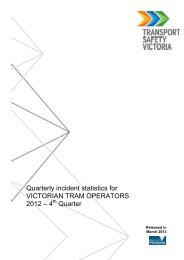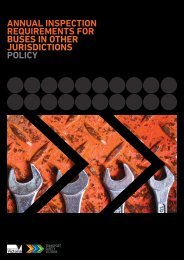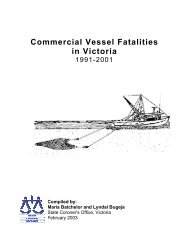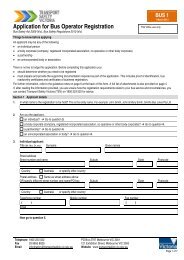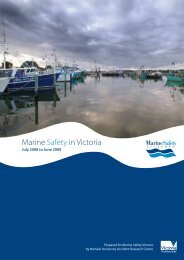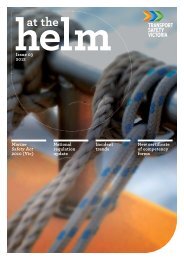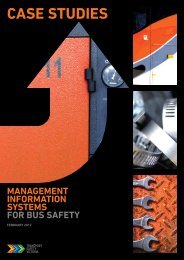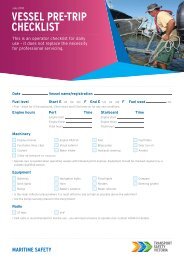Marine Safety in Victoria Report 2007-2008 (PDF, 1.3 MB, 72 pp.)
Marine Safety in Victoria Report 2007-2008 (PDF, 1.3 MB, 72 pp.)
Marine Safety in Victoria Report 2007-2008 (PDF, 1.3 MB, 72 pp.)
You also want an ePaper? Increase the reach of your titles
YUMPU automatically turns print PDFs into web optimized ePapers that Google loves.
5.5.5 W<strong>in</strong>dsurf<strong>in</strong>g and kitesurf<strong>in</strong>g (n=39)<br />
There were 19 admissions and 20 ED presentations for <strong>in</strong>juries related to w<strong>in</strong>dsurf<strong>in</strong>g and kitesurf<strong>in</strong>g.<br />
5.5.5.1 Hospital admissions (n =19)<br />
The VAED does not currently have a separate code for w<strong>in</strong>dsurf<strong>in</strong>g and kitesurf<strong>in</strong>g. We presume that<br />
kitesurf<strong>in</strong>g cases are currently be<strong>in</strong>g coded under the w<strong>in</strong>dsurf<strong>in</strong>g code. There were 19 recorded<br />
admissions <strong>in</strong> 2006/7 compared with 23 <strong>in</strong> 2005/6. Seventy-n<strong>in</strong>e percent of admitted cases (n=15) were<br />
male. Thirteen cases were young adults aged between 20 and 44 years (68%). Hit/struck/crush was the<br />
major cause of <strong>in</strong>jury (37%), followed by near drown<strong>in</strong>g or submersion and on-board <strong>in</strong>cidents (both 16%).<br />
The lower extremity was the most frequently <strong>in</strong>jured body region (47%, to the hip, thigh. knee, lower leg,<br />
ankle or foot), followed by the u<strong>pp</strong>er extremity (21%, to the shoulder, u<strong>pp</strong>er arm, wrist or hand), then<br />
head/face/neck (16%, mostly head). The shoulder and knee were the most commonly <strong>in</strong>jured body sites.<br />
The most frequently occurr<strong>in</strong>g <strong>in</strong>juries were fractures (42%) and dislocations/spra<strong>in</strong>s/stra<strong>in</strong>s (21%).<br />
Only 3 admissions were recorded on the VEMD (all kitesurf<strong>in</strong>g <strong>in</strong>cidents). Two case narratives provided<br />
some more detail of the <strong>in</strong>jury <strong>in</strong>cidents: one kitesurfer was dragged 30 metres across a carpark and the<br />
other surfed <strong>in</strong>to a brick wall.<br />
5.5.5.2 Hospital ED presentations (n =20)<br />
Eleven (55%) of the 23 cases present<strong>in</strong>g to EDs were w<strong>in</strong>dsurfers and n<strong>in</strong>e (45%) were kitesurfers. All were<br />
male. Cases were found <strong>in</strong> every 5-year age group from 15-19 to 60-64 years with 40% aged <strong>in</strong> their 30s.<br />
Dislocation/spra<strong>in</strong>/stra<strong>in</strong>s were the most common <strong>in</strong>juries (35%), followed by fractures and open wounds<br />
(both 20%). The shoulder (20%) and knee (15%) were most frequently <strong>in</strong>jured.<br />
Most <strong>in</strong>juries were caused by falls off w<strong>in</strong>d/kite surfer (45%) and struck by/collision with objects (25%, such<br />
as w<strong>in</strong>dsurfer/boom/bar/mast).<br />
5.5.6 Fish<strong>in</strong>g from a boat (n=28)<br />
All 3 boat<strong>in</strong>g-related fatalities recorded on the NCIS <strong>in</strong> 2006/7 were fishers. Data on hospital-treated boat<br />
fish<strong>in</strong>g <strong>in</strong>jury underestimate the number of serious <strong>in</strong>juries associated with fish<strong>in</strong>g from boats. There are<br />
no activity sub-codes <strong>in</strong> the VAED to disaggregate cases coded to ‘activity - fish<strong>in</strong>g’ on the basis of site<br />
(boat, jetty, bank etc.) The only fish<strong>in</strong>g activity that is coded separately is rock fish<strong>in</strong>g. As a result of this<br />
cod<strong>in</strong>g issue, the only ‘fish<strong>in</strong>g from boat’ <strong>in</strong>jury hospitalisations identifiable on the VAED are those that<br />
have been assigned to a ‘water transport’ external cause code; there were 17 such cases. Fifteen were male<br />
(88%). There were 3 cases <strong>in</strong> age groups 30-34 and 65-69 years, two <strong>in</strong> age groups 40-44 and 55-59 years<br />
and one <strong>in</strong> each of the rema<strong>in</strong><strong>in</strong>g 5-year age groups up to age 75 years.<br />
Twelve cases (71%) were due to on-board <strong>in</strong>cidents (no further detail), three (18%) were caused by an<br />
accident to craft, and two (12%) were coded to ‘other and unspecified’ water transport accident. Injuries<br />
were mostly to the head/face/neck (35%), followed by the trunk and lower extremity (both 30%) then<br />
the u<strong>pp</strong>er extremity (6%). The most common <strong>in</strong>jury was fracture (occurr<strong>in</strong>g <strong>in</strong> 53% of cases). Seventy-one<br />
percent of cases (n=12) stayed <strong>in</strong> hospital less than two days, 24% (n=4) had a stay of 2-7 days and 6% (1<br />
case) stayed between 8 and 30 days.<br />
58



